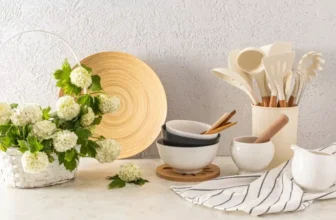
When looking to infuse minimalism into your kitchen design, it’s essential to start by decluttering and simplifying your space. By clearing out unused items and opting for clean lines, you can create a sleek and efficient kitchen. But that’s just the beginning. To truly embrace minimalism in your kitchen, there are other key elements to consider that go beyond just the aesthetics. So, what are these elements, and how can they transform your kitchen into a minimalist haven?
Decluttering and Simplifying
When aiming to incorporate minimalism into your kitchen design, begin by decluttering and simplifying your space. Start by going through your kitchen cabinets and drawers. Remove any items that you no longer use or need. Consider donating or selling these items to clear out the excess. Keep only the essentials within reach to create a clean and organized look.
Next, assess your countertops. Clear off any unnecessary appliances, decorations, or clutter. Leave only a few essential items, such as a coffee maker or a fruit bowl. This won’t only make your kitchen look more spacious but also make it easier to clean and maintain.
Don’t forget about your pantry and refrigerator. Dispose of expired items and consider donating non-perishable foods that you won’t consume. Organize your pantry with storage containers to keep everything in its place and easily accessible.
Opting for Clean Lines
Consider embracing sleek and uncluttered designs when opting for clean lines in your kitchen space. Clean lines are a fundamental aspect of minimalism, creating a sense of simplicity and sophistication. To achieve this look, opt for kitchen cabinets with minimal detailing or go for handle-less designs for a seamless appearance. Choose appliances with streamlined silhouettes and integrated features to maintain a cohesive look throughout your kitchen. Additionally, consider using materials like stainless steel, glass, or concrete to enhance the modern and minimalist aesthetic.
Incorporating clean lines in your kitchen design can make the space feel more spacious and organized. Avoid ornate patterns or excessive decorations that can clutter the visual appeal of your kitchen. Instead, focus on creating a harmonious flow by keeping the design simple and straightforward. By prioritizing clean lines, you can achieve a sleek and contemporary look that promotes a sense of tranquility and functionality in your kitchen.
Choosing Functional and Multi-Purpose Pieces
To enhance the functionality and versatility of your minimalist kitchen design, focus on selecting pieces that serve multiple purposes efficiently. Look for kitchen items that can perform more than one task to maximize space and utility. For example, consider investing in a kitchen island that doubles as a dining table or has built-in storage for your cookware. Opt for appliances that have multiple functions, such as a convection microwave oven or a combination coffee maker and grinder. These multi-purpose pieces not only streamline your kitchen space but also reduce clutter and simplify your cooking routine.
Another way to incorporate functionality into your kitchen design is by choosing furniture with hidden storage compartments. Select chairs with under-seat storage or tables with drawers to keep your kitchen essentials organized and out of sight. Additionally, wall-mounted shelves or magnetic racks can serve as both storage solutions and decorative elements, adding to the efficiency and aesthetic of your minimalist kitchen. By carefully curating functional and multi-purpose pieces, you can achieve a minimalist kitchen design that’s both practical and stylish.
Embracing Neutral Colors
Incorporate neutral colors into your minimalist kitchen design to create a serene and timeless aesthetic. Neutral colors such as whites, creams, greys, and beiges serve as a perfect foundation for a minimalist kitchen. These hues provide a sense of tranquility and openness, making your space feel more spacious and inviting. By using neutral tones on your walls, cabinets, and countertops, you can achieve a cohesive and sophisticated look that will stand the test of time.
To enhance the minimalist feel, consider adding natural elements like wood accents or green plants to complement the neutral color palette. These touches can bring warmth and life to your kitchen while maintaining the clean and simple aesthetic of minimalism. Additionally, incorporating stainless steel appliances or matte black fixtures can create a sleek contrast against the neutral backdrop, adding a modern touch to your design.
When choosing neutral colors for your kitchen, opt for tones that resonate with you personally and create a calming atmosphere. Remember, simplicity is key in minimalist design, and neutral colors can help you achieve a harmonious and balanced space.
Kitchen Appliances














